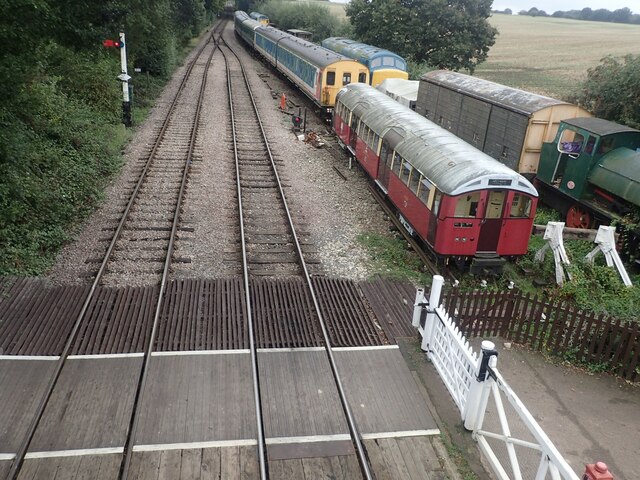View from the footbridge at North Weald station
Introduction
The photograph on this page of View from the footbridge at North Weald station by Marathon as part of the Geograph project.
The Geograph project started in 2005 with the aim of publishing, organising and preserving representative images for every square kilometre of Great Britain, Ireland and the Isle of Man.
There are currently over 7.5m images from over 14,400 individuals and you can help contribute to the project by visiting https://www.geograph.org.uk

Image: © Marathon Taken: 8 Oct 2021
The Eastern Counties Railway Loughton branch line opened on 22nd August 1856. It ran north-east between the small villages of Leyton and Leytonstone, reaching the Roding Valley at Wanstead. It then followed the west side of the valley to reach Loughton which was then a village of 1,500 people. At the time Epping was a small agricultural town of just over 2,000 people along the Newmarket Road and five miles to the east was the town of Chipping Ongar. An eleven and a quarter mile extension beyond Loughton was opened as a single line extension from Loughton through Epping to Ongar on 24th April 1865. A double track was completed as far as Epping in January 1893. At the opening of the Loughton branch most trains terminated at Fenchurch Street, but from 1874 most trains were diverted to Liverpool Street. By the outbreak of the Second World War much of the land between Epping Forest and the River Roding was covered with houses as far as Loughton but there was much discontent with the LNER steam service. Tube train operation of the branch was first mooted in the early 1930s and a major objective of the 1935-1940 London Railways New Works Programme was to give the eastern suburbs of London a more direct link to the West End. The Central line would be extended beyond Stratford to Leyton where it would take over the working of the Ongar line. The new station at Loughton was opened on 28th April 1940 but LNER steam trains served it until 1948. Work resumed in 1945 and Tube trains reached Leytonstone on 5th May 1947. Loughton received its electric trains on 21st November 1948. Electrification was carried through to Epping on 25th September 1949. GER tank engines ran through to Ongar for a further eight years until it was decided to electrify the single line and Tube trains arrived at the remote Ongar station on 18th November 1957. After Tube trains arrived Epping soon showed signs of suburban growth. However, much of the line beyond was rural and because of low usage and prospective heavy engineering work, London Transport sought to close the Epping Ongar section in 1970. However, trains continued to run until 30th September 1994 when the line was finally closed. The track remains though and heritage trains are now run by the Epping Ongar Railway - see http://eorailway.co.uk/ North Weald is now the central base for the Epping Ongar Railway's motive power fleet. The station has been restored to its Great Eastern Railway appearance and is very much as it would have been during the LNER period of the early 1940s. The original signal box seen on the left here has been completely restored. In 2016 the original GER lattice footbridge, from which this view is taken, came from South Woodford further down on the Central line and was totally restored. It was brought here to replace the previously condemned London Underground concrete structure. This view looks towards Ongar from the footbridge at North Weald station. In 2016 the original GER lattice footbridge which came from South Woodford further down on the Central line was totally restored and brought here to replace the previously condemned London Underground concrete structure. See https://www.geograph.org.uk/photo/5471044 for a photograph of the footbridge. This was London Transport Weekend which celebrated the Epping Ongar Railway's links with London Transport. The collection of rolling stock on the up side is interesting.

